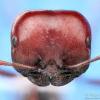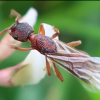On humidity, basically what drtmiller said. You would definitely have a great humidity gradient with that nest, but of course the concern is whether or not there's enough of it. I don't think your ants are going to dehydrate as long as you feed them, but a nest that is too dry is going to impact performance of many species. Two solutions exist that I personally would do right away, which I'll mention after giving you a way to pour grout in that nest. Your comment that you are willing to tweak/modify your nest is encouraging.
Good that you've disassembled it. Remove the cover, insert the bolts again and screw in the nuts to keep everything together, create some forms with cardboard and tape to the sides to hold the grout, then pour your grout in those spaces. Reattach cover. You will need to be creative on some parts of that nest, but it definitely can be done. However, CoolColJ is right that grout has a hard time absorbing moisture from the air unless everything around it is soaking wet. You'd have to re-imagine this entire design to expand the amount of contact areas that sponge is going to have with the grout. The water reservoir will need to get bigger to hold about 300-1000% more volume as well. On that note, it's interesting why such a big nest has such a small water tank; none of my business. I have some ideas but you might not want to implement them. Let me know if you want to go all out and I can tell you how. It seems that you want to add the grout because you are concerned about formic acid.
- See that sheet with the narrow slits that go against the sponge? Make them wider. Were they trying to ration out the water? Drill some holes if you can. This will create more surface area for the water to evaporate, increasing saturation in the immediate area. Or just cut out that piece completely.
- Heat the water. If you have a form of heating you use for your ants, apply it to the bottom of that formicarium. This will create a heat gradient, but more importantly it means that the upper levels that are colder will reach dew point and begin to have condensation forming on the acrylic. Heat also increases the rate of evaporation, increasing RH%, making it easier for condensation to form.
Like drtmiller implied, ventilation reduces humidity. However, it's an odd suggestion to glue the entire outer shell to prevent moisture from leaking out. It certainly is the fastest and cheapest(?) way to do it I suppose... Actually the fastest and cheapest way is to boil water, put some in a bowl, and place both that bowl and the formicarium in a small, enclosed space. Funny but that might be just what your formicarium needs to get started unless the gaps between the acrylic are huge, which I doubt. To me, the problem is not too much ventilation, but too much area to humidify and too little area for water to spread out. That is the real problem you have to deal with sooner or later. Both of which can be fixed, but may require a bit more investment on your part. I'd be happy to help but I won't waste time detailing a redesign/remodel that will never happen. If you're interested, just say so.
If the warped(?) pieces are causing holes, fix them. Tighten the nuts and bolts properly and that nest should be watertight? Airtight is not equal to watertight but it doesn't matter since water molecules are larger than the ones found in air not to mention hydrogen bonds. Unless I'm missing something crucial about your nest, I don't see why you'd be losing too much moisture due to airflow. Once again, the real problem is the ratio of area to humidify versus means to do so. While other solutions exist, the two mentioned above are the most simple ones: Cut larger holes and heat the water/bottom of formicarium.































